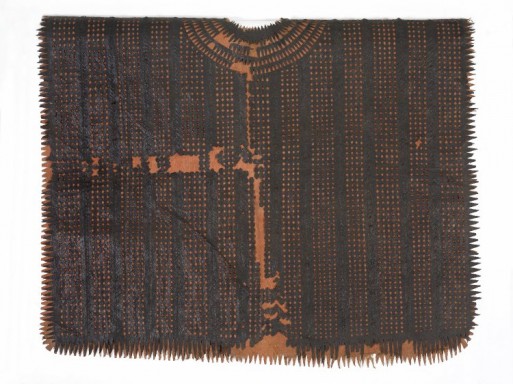Reflecting on the material items various countries associate with death and dying can be telling on both a ritualistic and practical level (ex. “Western” culture’s penchant for wearing black to funerals; South Korea’s move towards “burial beads” in the wake of over-crowded cemeteries). Consider bark cloth, which is believed to have originated from Africa and has long been used to create mourning garments in Borneo and Polynesia.
Bark cloth is essentially what it sounds like: a fabric made from the bark of a tree like fig or mutuba – it depends on the region, really – through the work of very skilled hands.
“…bark cloth has long been used to create mourning garments in Borneo and Polynesia.”
First, one has to find “the best beating rhythm to beat a cloth from [the] bark,” explains Arte International, which specializes in the craft, “Only under these [certain] conditions [with] the right mixture of time, rain and sunshine does bark cloth reveal its unique structure, suppleness and depth.”
The use of bark cloth goes back pretty much as far as historians can trace. The Pagan Tribes of Borneo (1912) describes the integral use of the fabric in mourning the loss of a loved one:
The whole household of which the dead man was a member continues in mourning for a period which is long in proportion to his social standing; the mourning rules are observed most strictly by the nearest relatives. The signs of mourning are the wearing of bark cloth or of clothes made yellow with clay…
There’s something very grounding about the fabric’s role in mourning. Although the reasons for its use can be chalked down to a practical basis, it’s also nice to think that the use of a fabric so ‘rooted’ in nature carries particular meaning: a nod to a loved one’s own return to the earth.
Explore more of SevenPonds’ Cultural Perspectives here.

 Bark Cloth: The Oldest Mourning Garment?
Bark Cloth: The Oldest Mourning Garment?





 John Mulaney’s “Funeral Planning” on Netflix: No Real Plan
John Mulaney’s “Funeral Planning” on Netflix: No Real Plan

 Composting Bodies Is Now Legal in a Dozen States
Composting Bodies Is Now Legal in a Dozen States














